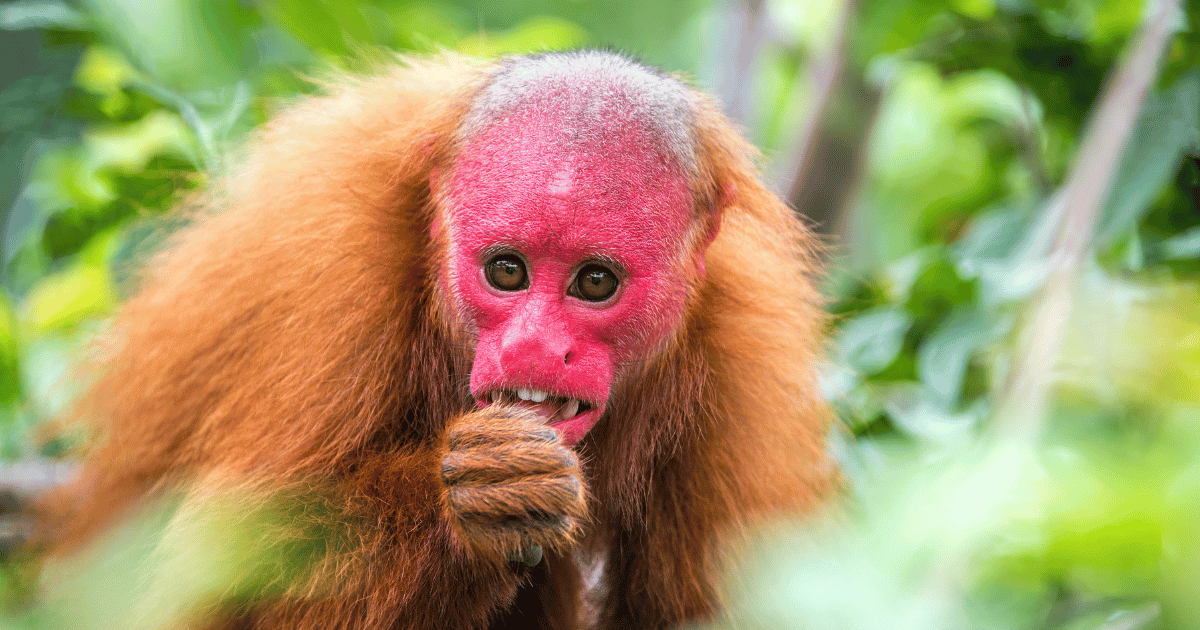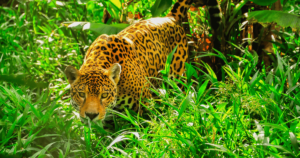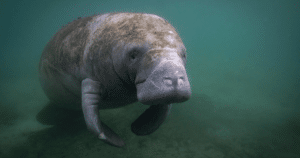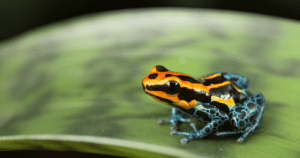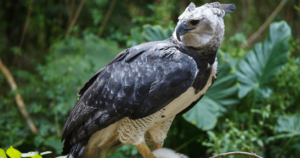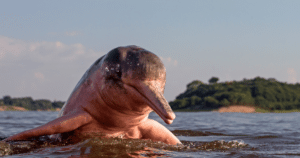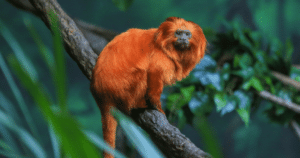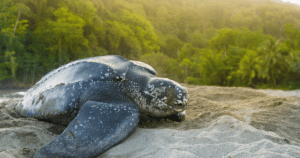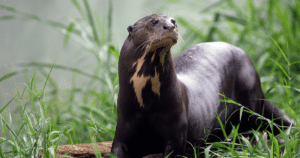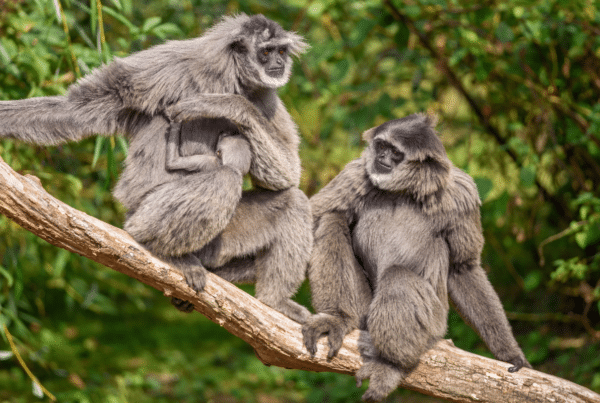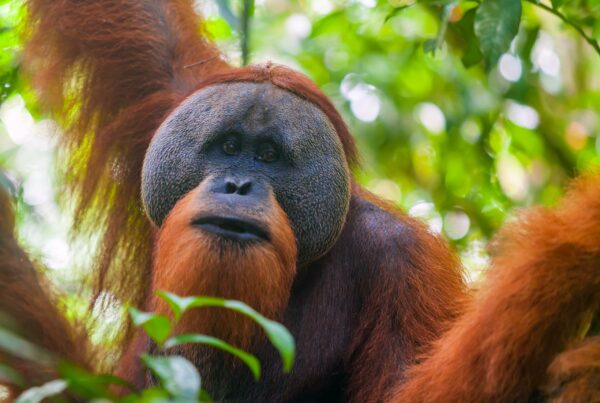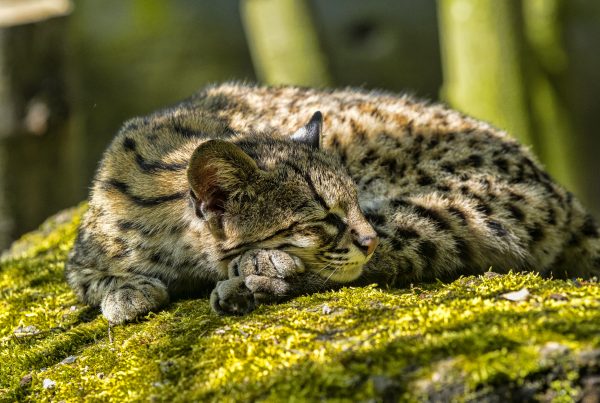The Amazon Rainforest, often referred to as the “lungs of the Earth,” is a vast and biologically rich environment that is home to a staggering array of wildlife. Unfortunately, this incredible biodiversity is under threat from deforestation, climate change, and illegal wildlife trade. This all puts more than 2,300 animals at high risk of extinction in the Amazon.[1] As we step into 2024, it is more crucial than ever to focus on the conservation of endangered species that call this rainforest their home. Here are eight Amazon Rainforest endangered species that urgently need our help:
8 Amazon Rainforest Endangered Species
1. Jaguar (Panthera onca)
- Population: Estimated to number fewer than 15,000 in the wild, highlighting a drastic decline due to human activities.
- Unique Fact: Jaguars are exceptional swimmers, preying on aquatic animals like fish and caimans. Their role as apex predators is crucial in maintaining the ecological balance of their habitat.
- Threats: Extensive habitat loss from agricultural expansion, illegal hunting for their beautiful pelts, and conflict with farmers.
- Conservation Focus: Efforts to mitigate habitat destruction and create corridors for safe passage are essential. Jaguar conservation is pivotal for maintaining the ecological balance within their habitat, emphasizing their role as a keystone species in the Amazon ecosystem.
2. Amazonian Manatee (Trichechus inunguis)
- Population: Their secretive nature makes accurate population counts challenging, but they are classified as vulnerable.
- Unique Fact: The Amazonian manatee is distinctive for not venturing into saltwater and for having a unique white or pink belly patch.
- Threats: Water pollution, particularly mercury from illegal gold mining, and the destruction of their aquatic plant food sources due to damming activities.
- Conservation Focus: Protecting waterways from pollution and ensuring the sustainability of aquatic vegetation are crucial for the survival of the Amazonian manatee. Their conservation highlights the importance of clean and healthy river systems in the Amazon.
3. Poison Dart Frog (Dendrobatidae family)
- Population: The status varies significantly across species, with many facing critical endangerment.
- Unique Fact: These frogs’ vibrant colors warn predators of their toxicity—a defense mechanism derived from their diet of toxic ants and termites.
- Threats: Their survival is compromised by deforestation for logging and agriculture, alongside capture for the illegal pet trade.
- Conservation Focus: Addressing deforestation and the illegal pet trade, alongside preserving the frogs’ natural habitat, is vital. These amphibians are key indicators of environmental health, reflecting the pristine condition of their surroundings.
4. Harpy Eagle (Harpia harpyja)
- Population: Estimated at less than 50,000, with numbers continuing to fall.
- Unique Fact: Possessing the largest talons of any living eagle, they can lift prey up to their own body weight, playing a vital role in controlling populations of other animals.
- Threats: The loss of large swathes of forest eliminates suitable nesting sites, and they are also hunted and face reduced prey availability.
- Conservation Focus: Protecting large tracts of forest and preventing deforestation are imperative for the survival of this top predator. The harpy eagle’s conservation is symbolic of the broader efforts needed to safeguard the Amazon’s canopy ecosystem.
5. Amazon River Dolphin (Inia geoffrensis)
- Population: Though still numbering in the tens of thousands, their population is quickly diminishing.
- Unique Fact: These dolphins have an extraordinary neck flexibility that allows them to navigate through flooded forests during the wet season, unlike any other dolphin species.
- Threats: They face habitat disruption from dam construction, pollution from agricultural runoff, and accidental capture in fishing nets.
- Conservation Focus: Efforts to combat water pollution and protect against habitat fragmentation are crucial. The Amazon River Dolphin’s preservation underscores the interconnectedness of terrestrial and aquatic habitats in the Amazon.
6. Golden Lion Tamarin (Leontopithecus rosalia)
- Population: Only about 3,700 individuals remain in the wild, confined to Brazil’s Atlantic Forest.
- Unique Fact: As seed dispersers, they play a crucial role in the regeneration of their forest habitat, highlighting their ecological importance beyond their striking appearance.
- Threats: They suffer from severe habitat fragmentation and the illegal pet trade, which drastically reduces their numbers.
- Conservation Focus: Habitat restoration and reforestation projects are critical for their recovery. The Golden Lion Tamarin serves as an ambassador for the conservation of the Atlantic Forest, a crucial ecosystem within the Amazon region.
7. Green Sea Turtle (Chelonia mydas)
- Population: The global population is under threat, with less than 85,000 nesting females.
- Unique Fact: Adult green sea turtles are unique among sea turtles for their herbivorous diet, which helps maintain healthy seagrass beds and marine ecosystems. These marine turtles can reach speeds of up to 35 mph.
- Threats: They are vulnerable to the illegal trade of their eggs and meat, accidental capture in fishing gear, and loss of nesting beaches to coastal development.
- Conservation Focus: Some of the beaches along the Amazon River’s mouth serve as nesting sites for green sea turtles, so protecting nesting sites and reducing bycatch are essential actions. The conservation of green sea turtles highlights the need for marine conservation efforts in conjunction with rainforest protection.
8. Giant Otter (Pteronura brasiliensis)
- Population: Their numbers range from 1,000 to 5,000, emphasizing their endangered status.
- Unique Fact: Living in large, vocal family groups, giant otters have a complex system of communication. Their social structure is key to their survival, emphasizing the importance of protecting their aquatic habitats
- Threats: Pollution, overfishing that diminishes their food sources, and habitat destruction are significant threats.
- Conservation Focus: Safeguarding their aquatic habitats from pollution and overfishing is paramount. The conservation of giant otters brings attention to the importance of preserving the Amazon’s rivers and lakes.
Why Are Amazon Rainforest Species Going Extinct?
Why Are Amazon Rainforest Endangered Species Crucial?
Should we choose inaction, the consequences would be multifaceted.
Each of these species plays a pivotal role in their ecosystems, contributing to the delicate balance that sustains the Amazon Rainforest. Their decline is not just a loss of biodiversity but a signal of the broader environmental crises threatening our planet. Ecosystems like the Amazon furnish us with essential resources for survival, including clean air, water, and soil, along with fresh food and medicinal resources, not to mention the aesthetic and inspirational benefits of lush landscapes and diverse wildlife. Preserving these species and their habitats is vital for maintaining the health of the rainforest, which in turn affects global climate regulation and biodiversity.
Conservation Efforts and How You Can Contribute
Conservation efforts involve habitat protection, anti-poaching measures, breeding programs, and community engagement initiatives. These efforts aim to address the root causes of endangerment, from combating deforestation to reducing pollution and promoting sustainable resource use.
How to Help:
- Support Conservation Organizations: Financial contributions to groups working on the ground can fuel vital conservation projects.
- Adopt Eco-Friendly Habits: Simple lifestyle changes, such as reducing waste, conserving water, and choosing sustainable products, can have a significant impact.
- Raise Awareness: Educating those around you about the importance of the Amazon Rainforest and its endangered species can inspire collective action.
Which Stand For Trees Projects Support Amazon Rainforest Wildlife?
As we look at ways to protect the Amazon Rainforest and its endangered species, it’s important to highlight the pivotal role of Stand For Trees projects in aiding wildlife conservation efforts in this vital area. Stand For Trees, through its innovative approach, supports a range of projects specifically designed to conserve the Amazon’s unique biodiversity by preventing deforestation and promoting sustainable practices. These projects not only aim to protect the vast expanses of the rainforest but also seek to ensure the survival of its countless inhabitants, including the endangered species detailed earlier. Here are our incredible Amazon Rainforest conservations that need all the support they can get:
What’s better than turtles? Baby turtles. They are raised and reintroduced into the Jurua and Valparaiso rivers by this project. What’s more, it protects 28,000 hectares of pristine tropical rainforest in the Amazon Basin and supports sustainable agriculture and ranching in local communities.
The jaguar is the flagship species of the area and has declined by 25% in the last 20 years due to habitat loss, trophy hunting, and illegal trade. In addition to the jaguar, Amazon Valparaíso protects critical habitat for at least 25 species, including the lowland tapir and short-eared dog.
This project helps prevent 19 million tonnes of emissions, the equivalent of powering 3.2 million homes, by saving 180,000 hectares of some of the most diverse and fragile forests on the planet in Pará, Brazil.
The prevents ecosystem fragmentation and loss, thus providing a safe and functional environment for at least 30 threatened or vulnerable species, including the Ka’apor capuchin monkey, black-bearded saki, black-handed tamarin, giant anteater, giant otter, and golden parakeet.
This project helps preserve a remote tropical rainforest that was in danger of becoming a cattle ranch. The region hosts an extraordinary amount of tropical, endangered, and/or endemic birds, such as the blue-headed macaw and Amazonian parrotlet. The project also conserves habitat for threatened tree species such as bigleaf mahogany.
In a world increasingly transformed by the hands of humans, this project protects a rare expanse of untouched forest the size of the US state of Connecticut, known as the ‘jewel of the Peruvian Amazon’.
The park protects healthy populations of endangered mammals, including spectacled bears, cougars, jaguars, bush dogs, river otters, giant armadillos, woolly monkeys, and spider monkeys. It is also home to iconic birds and species such as the scarlet-banded barbet, giant armored catfish, majestic harpy eagle, razor-billed curassows, and a variety of parrots and macaws.
This project prioritizes indigenous-led development by scaling up sustainable community forest management. It preserves 120,000 hectares of tropical forest, and improves the livelihoods of seven remote indigenous communities on the edge of the Peruvian Amazon.
The project protects tropical habitat home to an abundance of species, notably the near-threatened jaguar and the blue-headed macaw and tapir, both classified as vulnerable by IUCN.
In Sum
The Amazon Rainforest is a treasure trove of biodiversity, and its protection is critical for the health of our planet. By focusing on the conservation of these endangered species, we can work towards a future where the Amazon, and its incredible inhabitants, thrive for generations to come. Stand with us in 2024 to save these magnificent species and preserve one of the earth’s most vital ecosystems.
The bottom line? Forests like the Amazon Rainforest need wildlife as much as wildlife needs the Amazon Rainforest. And wildlife conservation is as much a task for organizations like Stand For Trees as it is for people like you.
[1] https://www.reuters.com/business/environment/over-10000-species-risk-extinction-amazon-says-landmark-report-2021-07-14/
[2] https://www.iucn.org/



